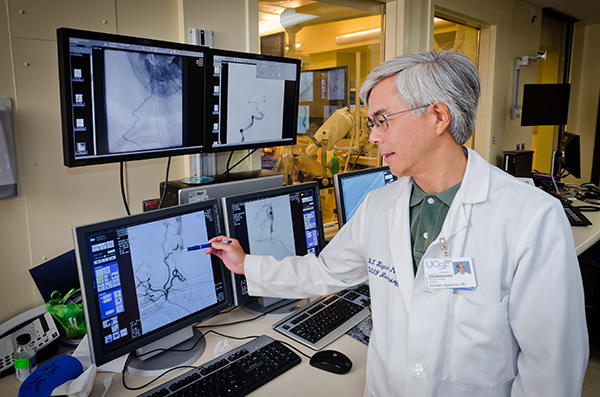A Case Where CT Perfusion Abnormalities Helped Diagnose RCVS After Carotid Artery Surgery

Carotid endarterectomy (CEA), also known as carotid artery surgery, removes plaque buildup from inside a carotid artery in a patient’s neck. It is often performed to prevent a stroke by restoring normal blood flow to the brain. CEA is a safe procedure when performed by experienced surgeons, but serious complications can occur.
Reversible cerebral vasoconstriction syndrome (RCVS) – a condition characterized by severe headaches and a narrowing of the blood vessels in the brain – is a rare, yet serious complication that can occur after CEA. It can be treated effectively, but a delay or missed diagnosis can result in cerebral ischemia, cerebral infarction (stroke), and permanent neurologic deficits.
A team of physicians from the UC San Francisco Departments of Neurology and Radiology and Biomedical Imaging, Neuro Interventional Radiology (Neuro IR) section, recently presented a novel case where computed tomography (CT) perfusion imaging studies demonstrated abnormalities that have not been previously described in patients with RCVS. The full case review with images was recently published in the Journal of Vascular Surgery Cases and Innovative Techniques.
“In this case report, we discuss a patient who had recently undergone CEA and presented with acute neurologic deficits,” says Masis Isikbay, MD, PGY3 resident and an author on this study. “There is a broad differential diagnosis, highlighting the importance of patient evaluation including history, physical examination, lab analysis and diagnostic imaging. All the members of the clinical team involved in this patient’s care were important in helping make this rare diagnosis.”
Brain perfusion imaging, also known as CT perfusion imaging, is a component of CT stroke protocol study. It might be required as a part of the diagnostic evaluation and can complement vessel imaging and MRI.
“Results from the patient presented in the case report highlight the value of CT perfusion imaging,” says Kazim Narsinh, MD, Neuro IR clinical fellow. “It can help identify areas of reversible ischemia, which can be caused by RCVS, shown for the first time in the present case. Quickly identifying perfusion abnormalities is critical to delivering timely interventions to avoid stroke. We hope our presented case can draw attention to the nuances of RCVS, so all members of the care team for patients in this population will consider this as a possible diagnosis. Managing these types of patients is a group effort.”
Findings combined with the cerebral angiography findings, led to rapid diagnosis and delivery of intra-arterial vasodilator therapy, and the patient (who provided written informed consent) experienced resolution of symptoms and radiologic abnormalities.
Corresponding author on this paper is Matthew Amans, MD, whose clinical focus is on the treatment of acute stroke, cerebral aneurysms, and other vascular anomalies. Dr. Amans is the director of the Neuro IR Fellowship Program at UCSF Radiology. Additional authors from the Neuro IR section include Randall Higashida, MD (section chief), and Daniel Cooke, MD (associate professor).
Sergio Arroyo, MD, PhD, clinical fellow, and Wade Smith, MD, PhD, director of the UCSF Neurovascular Service are authors from UCSF Weill Institute for Neurosciences, Department of Neurology.
